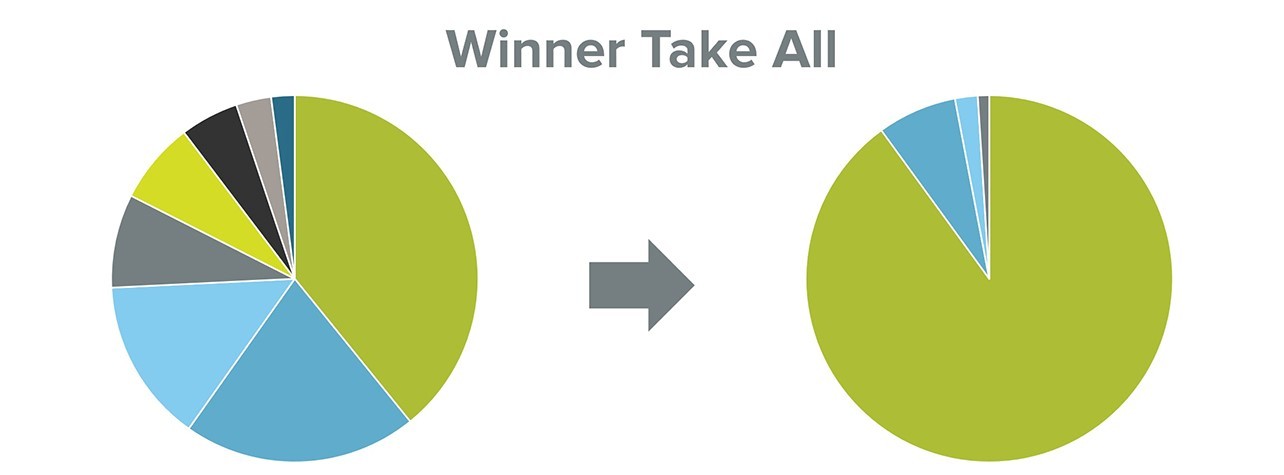
The innovator’s dilemma
In his 1997 bestselling book, The Innovator’s Dilemma, Clayton Christensen argues that large firms often miss out on opportunities to grow because innovative products with disruptive potential are rejected by most customers, due to their higher defect rate. As a result, smaller competitors are able to go to market with less mature products that meet the needs of lower-end customers. From there, these innovators move up-market as they refine their products over time. This was the case with televisions, radios, mobile phones, disk drives, and many other major breakthroughs.
Big bang disruption
Fast forward to 2013. Larry Downes and Paul Nunes publish an article in Harvard Business Review entitled Big Bang Disruption. They suggest that technological advances have sped up innovation to the point that industry disruptors no longer rely on selling a flawed product to the lower end of the market. In fact, innovators hit the market with a product that may be better, faster, more customized, and cheaper—all at the same time. This Big Bang is the result of converging technologies like mobile, cloud, and analytics. It’s accelerated by the fact that the delivery model is via a networked digital infrastructure. Think of the impact Uber had on taxis or Google Maps on handheld GPS devices. These offers both leverage digital networks to drive usage and scale.
The path to Big Bang disruption is non-linear and unpredictable. Facilitated by what Gartner has dubbed the Nexus of Forces—cloud, social, mobile, and big data—Big Bang disruptions can happen seemingly overnight, leaving industry leaders little time to respond. Understanding disruption and addressing it effectively has become one of the top priorities in the C-suite today. It’s a recurring theme in our conversations with clients—particularly those running technology-enabled businesses. Here are a few ways that we see the Big Bang impacting business and what you can do to respond.
Industry structure
With the move to the cloud well underway for most businesses, hardware and software are turning into commodities. That’s because users are more interested in what the solution does than what platform it runs on or who makes it. With less physical infrastructure, easier integration and deployment, and subscription pricing, switching costs are declining rapidly. These trends are speeding up the progression to market leadership, defining winners and losers in the marketplace faster than ever. The resulting “winner take all” phenomenon has a major impact on share within each disruptive market.

And market share isn’t the only thing changing. Barriers to entry are increasingly not barriers at all. In many cases, companies are simply jumping into a new sector or market. Hardware and software companies become cloud companies. Point-solutions move up the value chain to provide integrated solutions. Channel partners become solutions providers, etc.
Customer behavior
The Big Bang is affecting customer behavior as well. Customers expect access to information when and where they need it. They also expect to get a highly personalized experience and to pay on a consumption basis. If you’re like me, you probably did most of your Christmas shopping online this year. But, if you did go to the mall, you probably saw the few people that were there walking around, looking at their phones—comparing online and instore prices, reading reviews, checking availability, and looking at their kids’ Amazon wish lists.
Even in the B2B world, the Big Bang has had a radical impact on customer behavior. Buying decisions are no longer limited to the CIO or the Line of Business Executive. End users (i.e. workers and managers) within an organization are making incremental purchases and deploying cloud-based solutions with little or no input from IT departments—just bill a credit card and put it on the expense report. Employees are increasing their productivity and expect to be able go out and get the tools they need to do their job on an on demand basis.
Go-to-market
As technological disruptions accelerate, industry structures change, and customer behavior and patterns evolve, smart executives are finding ways to adjust business models, offerings, and go-to-market strategies (GTM). The most successful companies are doing two things. First, they’re listening more closely than ever to customer needs. Those needs are changing quickly, and it doesn’t take long for competitors to meet them. Second, they’re developing new disruptive businesses alongside their core business. This helps them respond to customer needs and competitive pressures. Some achieve this via internal efforts (intrepreneurship) and some through acquisition (M&A).
Next Steps
The first step to handling the Big Bang is recognizing that accelerated technological disruption is moving forward with or without you. Those who come to this realization sooner rather than later will be equipped to survive and thrive in the future. Once you’ve recognized this reality, there are five key steps to consider.
- Conduct a strategic assessment. You’ll need to understand the business landscape and your own key leverage points.
- Understand customer needs. Leverage social platforms, big data, and business analytics to understand what customers want to see from your business, not just today, but in the future too.
- Update your offers to meet customer needs. Don’t just wait for pressure from your competitors. Anticipate customer needs and drive innovation with evolving customer needs in mind. Better to disrupt yourself than have a competitor disrupt you.
- Redefine your GTM strategy. If you’ve learned from the market, listened to your customers, and understand your leverage points, you may find yourself in an entirely new market with new partners and sales approaches.
- Learn and adapt. You’ll be most successful if you commit to continuously pilot, refine, and rollout new offerings and capabilities to your core business. Executive commitment and organizational processes are key to success.
Big Bang disruption brings both challenges and opportunities for all of us, but those who leverage its potential to drive innovation will be the winners.
